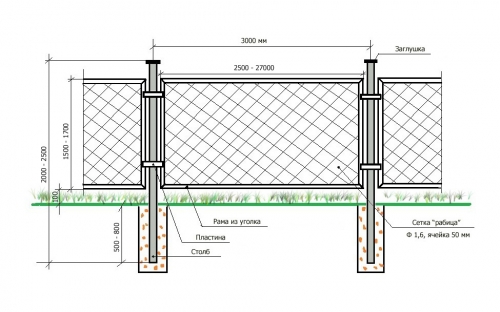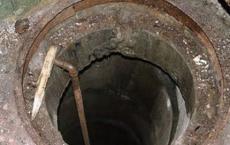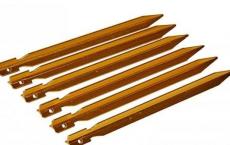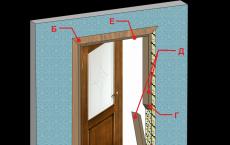Do-it-yourself fence construction in the country house
The construction of a country fence is a rather laborious process. However, thanks to our instructions, you will learn how to make a fence in the country and significantly save time and effort. In the last article, we examined typical options for country fences, using the example of which you can build a fence from any material. But we will describe the features of the construction of the structure from each of them below. A huge role in the durability and strength of the entire structure is played by the reliability of supporting structures and foundations.
Foundation - the basis of the design of the fence
In order for the country fence to stand on your site for more than a dozen years, you need to approach its construction thoroughly. The guarantee of the reliability of the fence is a properly laid foundation and well-installed supports. The foundation of the fence, like that of residential buildings, is tape and pole.
Strip foundation
It is customary to pour the strip foundation under the heavy structures of the building, on heaving soil, if necessary, to create a completely fenced area that is not visible from the outside, if it is necessary to exclude the penetration of wild animals and other living creatures into the dacha.
The foundation tape for the fence is made using the following technology:
- Dig a trench 30 - 80 centimeters deep, for greater reliability, go deep to a depth of 1.5 meters.
- Make a sand cushion, which is abundantly poured with water.
- Tie the reinforcement, vary the size of the cell depending on the desire.
- Erect the formwork of the foundation of the fence in such a way that the fence canvas is located at a height of 30-50 centimeters above the ground.
- The formwork is filled with concrete mortar. If you are using posts as support for the canvas, they must be installed and leveled before the foundation is poured.

Pillar foundation
The pillar foundation is more economical and is suitable, first of all, for light building envelopes. When erecting a wooden fence on a pole foundation, it is important to treat all wooden parts with a special compound that prevents decay, because such structures are more exposed to moisture from grass. A well-thought-out and correctly made fence on such a foundation is no less durable than a fence on a strip foundation.
Technology for pouring a pillar foundation for a country fence:
- With a garden drill, dig holes for poles that have a depth of 100-150 centimeters. Make the diameter larger by 15-30 centimeters than the diameter of the pillars. The distance between the posts should be 2-3 meters, depending on the required span width.
- Pour 20 centimeters of sand with gravel or the sand itself into the pits, pour abundantly.
- After you have leveled the pillars, fill the pits with a solution of sand concrete, add crushed stone if desired.

The result was cemented poles for the country fence. Further, it is customary to attach spans to the pillars if you use ready-made structures, for example, from a chain-link mesh, or logs - horizontal guides where pickets are stuffed or a fence canvas is attached.
Corrugated fence
One of the popular materials for the construction of a country fence is corrugated board, which has many advantages. Installing a fence of this type in the country provides significant time savings, because the work goes quickly enough. You just need to determine the fence line along the perimeter of the site, put drains and poles, which should be sheathed with corrugated board.
Advantages of corrugated board
Such a fence does not provide outsiders with the opportunity to observe what is happening on the land, unlike a fence made of a lattice or chain-link. The corrugated board reflects the sound well and is a durable material, and also does not require the involvement of professionals, you just need to buy some tools.
For the fence, it is recommended to choose a corrugated board with a corrugation height of no more than 21 millimeters. Material with a higher height is not profitable to buy, as it is intended for roofing and has greater rigidity to withstand the seasonal mass of snow and rain.
Installation of a fence from a professional flooring
Before building a fence from corrugated board, it is worthwhile to calculate the perimeter of the building. You need to outline the position of the country fence and determine the location of the gate and gate, as well as determine the location of the pillars for support with an installation step of close to 3 meters. Then you need to determine what the height of the perimeter fence will be, as well as the height of the gate and gate. The length and number of corrugated sheets depends on these parameters.
Now install support pillars, which can be metal pipes that have a diameter of at least 80 millimeters. The side of the post that is directed upwards must be welded so that moisture does not get inside the pipe.
To place the poles, pits should be dug close to 1-1.5 meters deep and 1.5 meters wide. Make the foundation according to the technology described above. When it hardens, you can proceed with the installation of a transverse steel profile, on which the corrugated board should be mounted.

As a profile, take a profiled pipe, which has a cross section of 40 by 25 millimeters. Determine the number of pipes based on the height of the fence. If the height of the fence is up to 1.7 meters, then two rows of pipes are enough, which are fixed in parallel and installed at a distance of 30-40 centimeters. If the height of the fence is 1.7 - 2 meters, then you need to install pipes in three rows.
Fix the profile and support posts by electric welding. Then coat them with a primer to protect against corrosion. At the final stage, sheets of corrugated board should be fixed to the frame. This material is usually fastened with self-tapping screws at a distance of 50 centimeters. Neighboring sheets are usually joined together with an overlap.
When you install a corrugated fence in your country house with your own hands, do not forget to wear gloves, because you can get hurt on the sharp edges of the material. If during installation there are scratches on the corrugated board, it is worth using cans of paint to eliminate them. To achieve a better aesthetic appearance, it is possible to close the supporting pillars with brick or stone cladding, on this the installation of corrugated fences can be considered complete.
Chain link fence
As a sheathing for fences in a summer cottage, the chain-link mesh remains unrivaled in its popularity, because it meets all the requirements for reliability, light transmission and service life.
Types of chain-link mesh
Today, the following types of metal mesh are offered on the market: non-galvanized, galvanized and plastic-coated chain-link mesh. The first solution immediately disappears, because the time of its useful operation is minimal due to the lack of a protective coating against corrosion.

The chain-link mesh, which is lined with PVC, is primarily intended for building fences in warm climatic zones and on the coast of the seas, since plastic provides good protection against atmospheric moisture, but does not withstand seasonal changes in low and high temperatures. The optimal solution is still galvanized mesh.
Netting installation
Arrangement of a fence from a chain-link mesh begins with marking the position of the posts - intermediate and tension. The first columns are usually installed in increments of 3 meters, the second - after 9 meters. Use metal profiled racks as pillars, pipes that have a diameter of 60 millimeters or more and corners of 50 millimeters or more are suitable.
Under the intermediate pillars in the soil, use a drill to drill holes up to 40 centimeters deep, under the tension pillars you need a hole 60 centimeters deep. On clays and loams, concreting pillars is meaningless, because heaving soil is able to push the base out of concrete along with the pillar in cold weather. If the soil is light loam or sandstone, then the bases of the pillars can be concreted.

After installing the tension poles in place in the corners of the future fence, connect them to the adjacent poles with supports from the metal corner with bolts or welding. To attach the chain-link mesh, it is enough to have poles that are set at a 3-meter distance. In this case, the canvas will not sag.
However, such a fence is not reliable, because it is easy to lift the lower part of the skin and penetrate into the fenced suburban area. Therefore, a wire rod with a diameter of 3 mm is needed, which should be passed through the grid cells at three horizontal levels. To stretch the wire rod between the posts, drill three through holes in each of them.
Proceed to fixing the mesh on the posts - place it vertically near the support post and make sure that the bent ends of the lines are located at the top of the roll. Hook the top line of the net to the top of the post and move to the next post, gradually unwinding the roll. Having passed the wire rod through the chain-link mesh between adjacent posts, insert its ends into the prepared holes, pulling the wire and fixing it on the posts with tension bolts.
Slab fence
The slab is essentially a waste at any sawmill, which looks like shavings with wood chips. As a result, we can note the low cost per cubic meter of slab. If you are interested in which fence to put in the country so that it best emphasizes your frame house, choose a slab fence. On the one hand, this material is outwardly unsightly, but, nevertheless, it retains all the attractiveness of wood, which allows you to create both a cheap and pretty country fence.
Preparatory work
It is customary to start work on creating a fence with the debarking of a croaker - if you leave the bark, the structure will be hit by a bark beetle and will collapse soon. Removing the bark is a difficult task that requires the use of a special tool - a flat shovel with a sharp blade, a small carpenter's ax and a scraper. After removing the bark from the croaker, you need to sand its surface and cover it with several layers of antiseptic.

Support poles for fencing from slabs can be wooden and metal. Under the metal racks, a pipe is suitable, which has a diameter of 76 millimeters and a wall thickness of 3.5 millimeters, with welded plates that serve to fasten horizontal wooden girders.
Wooden fence posts are made of oak, pine or larch - the diameter of the trunk is 20 centimeters, the length is 2.3 meters. The side of the pillars that will be placed in the ground is covered in several layers with Kuzbass varnish or hot resin. If you plan to carry out runs from the slab, then make a distance of 2-2.5 meters between the fence supports.
Fence sheathing with slab
On loamy soil, metal and wooden poles are simply driven into the ground without additional strengthening measures; at the places of their installation, it is only necessary to drill holes with a drill and hammer the poles with a sledgehammer.
Chernozem and sandy soils require considerable effort - under each pillar you need to dig a hole 60 centimeters deep, 2 times wider than the pillar. Then, pour 10 centimeters of gravel into the bottom of the pit, tamp it down, place a pole in its center, fill in gravel around the perimeter, check the vertical position of the pole with a building level and plumb line, and compact the gravel tightly after setting up the pole.

Sheathing the fence with a slab is performed vertically or horizontally. In the first case, you need to attach a beam 50 by 30 millimeters on both sides to the support pillars and overlap the slab on self-tapping screws or nails - it will not work to fit the slabs end-to-end.
For the vertical sheathing of the country fence, the slab must be cut lengthwise, the sawn slab should be fixed to the girders with the convex side inward, leaving gaps of 40-50 millimeters between it, then closed with a slab, which is placed outward with the convex side. For a longer useful life, the finished slab fence should be painted or varnished, the ends of the pillars should be closed with metal or plastic cones - it will last about 10 years as a country fence.
Wattle as a country fence
Compared to other fences, wattle material is almost cost-free - it's cheaper just to do without a fence at all. However, such a fence will last no more than 3-4 years and the owners will only be provided with a decorative fence, which is unlikely to be able to resist burglary.
Procurement of material
The design of the wattle fence is no different from the installation of other types of fences - you need to make a foundation, you will need metal and wooden supports, and flexible rods for sheathing. Wooden racks are made of pine, and walnut and willow branches are best suited for sheathing, in the absence of which it is worth using branches of aspen, alder or birch.
It is customary to harvest rods for wattle sheathing in early spring or late autumn. To get started, watch a video about fences for a summer residence. Choose even and straight rods that have a thickness at the cut from the trunk of at least 30 millimeters and a length of 1.5 meters or more. Before harvesting, you need to check the branches of a bush or tree for a break by cutting off one twig and examining its cut.

If the core of the branch is large and has a reddish-brown tint, such rods are not suitable for sheathing, because they will break during installation. Therefore, you need to move on to the next tree and evaluate the core of the branches cut from it. The core should be barely visible. Having found the material that is suitable for creating wattle, cut the branches of the desired diameter and length, which are free of damage, knots and growths.
Dry the cut rods for a couple of hours, then remove the bark from them, after soaking them in water. For soaking, tie the rods into a bundle with a rope and immerse in water, placing a load on top. The soaking time is 7-14 days. Use a special tool to debark the rods. After removing the bark, sort the rods by length and thickness, then you can begin to arrange the fence.
Building a wattle fence in the country
Usually the distance between the supports is 350 millimeters or more. If for this you plan to use metal racks, then feel free to hammer them in pre-marked places. If the supports are wooden, then the stakes themselves should be prepared: sharpen the lower part of the stakes, which are intended for wattle supports, coat with heated resin in a segment that slightly exceeds the depth to which the supports will be driven into the ground.
A rubber or wooden mallet is required to drive in wooden supports and place sheathing rods between them, because a metal hammer can break wood. The supports that are placed along the edges of the wattle fence must be set at a not too great distance from the racks that are located nearby.

Before weaving, soak the rods for several days, they will become more flexible. To attach the branches, prepare annealed wire and copper. It is customary to weave from the bottom up - press the butt of the first rod with your right hand to the extreme support post, circle the rod along the second post with your left hand and bring it out beyond the third.
Lead the next branch behind the first support with the tip, hold it with your right hand, circle the second rack with your left hand and bring it to the third. The alternation of tops and butts will reduce the presence of gaps between the branches and avoid the slope of the rods, which are already intertwined, to one side of the fence.
So that when weaving the rods fit closer to each other, they are knocked down with a mallet. Fasten the ends of the rods to the uprights with annealed wire. To protect the ends of the support from getting wet during rain, equip them with galvanized caps or put clay caps on them.
Decorating a blind fence
Often, the owners of private houses and summer residents have a question - how to decorate a fence for a summer residence. Indeed, looking at a flat plane of a large area near your country house is not very interesting. Sometimes our fences are very long, and such blank walls do not decorate the space.
The first thing that comes to mind is closing a blind fence with climbing plants or shrubs, using vertical gardening techniques. Choose actinidia, girlish grapes or scented hops for this purpose. You can also plant annuals that curl along wire or ropes that are pre-stretched vertically.
Painting and painting is another option for decorating the fence. Also, on a blank fence, you can hang a planter with ampelous plants - petunias and pelargoniums. These hardy plants can bloom almost all summer long! Blind fences will serve well in the construction of the gazebo, because you already have one wall, you need two more supports, then you can proceed to the roof.
Along the fence of the summer cottage, you can make several flower beds raised above the ground. This technique can visually break a long fence into several parts, which will no longer look so monotonous. Plant tall flowers and shrubs with bright foliage in raised beds. If you prefer conifers, then remember that they are sensitive to the bright spring sun.
The construction of the fence allows the owner and his family to hide from prying eyes, as well as to protect their summer cottage. Next to a residential building, which looks beautiful, any fence will look good, and if you make the building yourself, it's even better. Modern technologies help in the aesthetic possibility of erecting a fence, which can be made from almost any durable material - brick, corrugated board, mesh, plants. The fence can be low, high, medium, exactly as you see it in your summer cottage.



